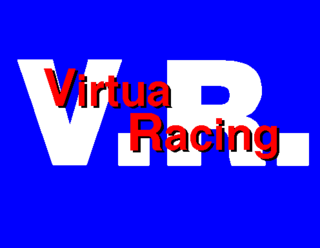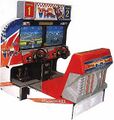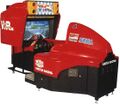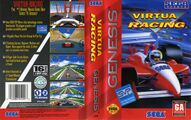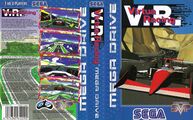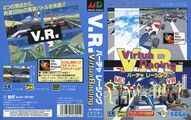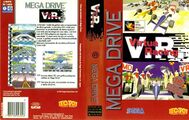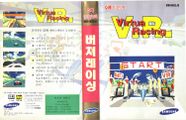Virtua Racing
From Sega Retro
This short article is in need of work. You can help Sega Retro by adding to it.
| Virtua Racing | |||||
|---|---|---|---|---|---|
| System(s): Sega Model 1, Sega Mega Drive | |||||
| Publisher: Sega | |||||
| Developer: Sega AM2, Sega AM4 (cabinet) | |||||
| Genre: Racing | |||||
| |||||
Virtua Racing (バーチャレーシング) is an arcade racing game developed by Sega AM2 and published by Sega in 1992. Virtua Racing was the first game released for the Sega Model 1 arcade platform, and also the first to use the name "Virtua" in its title (something which would be followed by numerous Sega arcade games, including Virtua Fighter, Virtua Cop and Virtua Tennis. It is considered a milestone in 3D graphics and the racing genre, and acts as a foundation for most modern racing games.
Contents
Gameplay
Tracks
The original release of Virtua Racing has the player race Formula 1 cars around three different tracks divided into difficulty:
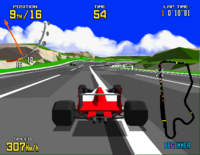
|
Big Forest |
|---|---|
| "Beginner" track. | |
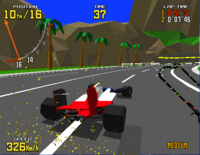
|
Bay Bridge |
| "Medium" track. | |
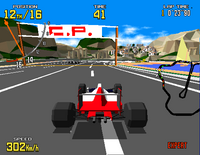
|
Acropolis |
| "Expert" track |
Versions
Virtua Formula
Special "medium sized" attractions, usually only seen at SegaWorlds or other Sega-themed amusement parks, adapt the eight-player setup and upgrade the cabinets, creating Virtua Formula. Virtua Formula first debuted in 1993, and is almost identical (bar name) to Virtua Racing, though considerably harder to find. It also features fancier attract modes, covering all eight screens (there are variants of Daytona USA which do this too). Many Virtua Formula cabinets were later converted into eight-player Indy 500 ones.
The multiplayer Virtua Formula version also featured an on-air camera, showing players' facial expressions on a monitor above the cabinet. The 4-player Virtua Formula deluxe cabinet cost £250,000 for arcade operators (equivalent to £433,854 or $686,492 in 2014), and £3 per play for players (equivalent to £5.21 or $8.24 in 2014).[3]
Mega Drive Version
Virtua Racing was an arcade success, and though expected to avoid home consoles for quite some time due to the complexity of the Model 1 arcade board, saw an initially surprising port to the Sega Mega Drive in 1994. The Mega Drive version utilises a custom made "Sega Virtua Processor" chip, allowing the game to render polygons similar to the "Super FX" chip within Star Fox for the SNES, although it's arguably a great deal more powerful than the Super FX; the Mega Drive port is surprisingly accurate.
Though the Mega Drive Virtua Racing is one of the more technically advanced Mega Drive games in the library, the unusual specifications of the cart mean that it is often one of the first games to not be supported by cost-reduced hardware (for example, it won't work with the Genesis 3). The Mega Drive version also takes a hit in terms of graphics and sound, displaying fewer polygons at a smaller resolution with a restricted palette and lower frame rate. However, it and all of the other home ports include two-player modes, time trials and options usually only available to arcade operators.
History
Development
Initially created as proof of concept program for the system, Virtua Racing was given the all-clear to become a fully fledged arcade title during the Model 1's development, thereby becoming one of the first fast-paced 3D racing games to appear in arcades. Prior to this, most 3D racing games had been simulations, and often running very slow. Though Namco and Atari Games had put forward 3D arcade racers some years prior with Winning Run (1988) and Hard Drivin' (1989) respectively, Virtua Racing was among the first to render its worlds in sixty-frames-per-second and offer support for multiple human players, and the first to include multiple camera angles adjustable during play.
It was also the first game to feature human characters rendered with 3D polygons, both as mechanics and spectators, in fully polygonal 3D environments. The polygonal 3D human models used in Virtua Racing later formed the basis for the character models seen in Virtua Fighter.[4]
Though the hardware was considered revolutionary at the time of release, Virtua racing was quickly outclassed by its successor, the Sega Model 2 board which debuted towards the end of 1993. There are no textured polygons in Virtua Racing, as Model 1 hardware did not support them. There is also only one vehicle, and although when linked together it is offered in several colours, the stats never vary. There is no damage model (crashing merely slows you down), and although there are differing surface types, anything "not road" merely slows the car down - it does not affect handling in any way (this would be pioneered by Sega Rally Championship some years down the line).
There are also very few music tracks: during races, only jingles of several seconds play as the user crosses checkpoints and the goal line for laps; however, this is likely stylistic.
Virtua Racing does, however, have an advantage in terms of resolutions and polygon counts - though the flat shading leads to unrealistic-looking worlds, Virtua Racing actually renders more polygons in real time than its logical successor, Daytona USA, which brought the genre further forward. It would also take home systems several years to "catch up" in these two areas.
Virtua Racing was only available to arcade operators as single or twin cabinets, however four of the twin units can be linked up to create an eight-player experience.
Legacy
32X Port
- Main article: Virtua Racing Deluxe
Mere months later, Virtua Racing was released as a launch title for the Sega 32X, in the form of Virtua Racing Deluxe. Deluxe adds two extra tracks and due to the increased power of the 32X, has a greater resemblance to the Model 1 release.
Saturn Port
- Main article: Time Warner Interactive's VR Virtua Racing
A Sega Saturn version of the game, officially titled Time Warner Interactive's VR Virtua Racing was brought to the console by Time Warner Interactive in 1995, sporting seven extra courses (on top of the three arcade tracks), four new cars and a grand prix mode among other additions.
Virtua Racing -FlatOut-
- Main article: Sega Ages 2500 Series Vol.8: Virtua Racing -FlatOut-
More recently, the game has been released as Virtua Racing -FlatOut-, part of the Sega Ages 2500 series on the PlayStation 2. This version includes an extra three new courses and four new cars to the Model 1 version.
Sega VR Version
A version of the game was also planned for the Sega VR, a virtual reality headset accessory for the Mega Drive/Genesis that was planned to release in fall 1993.[5] However, the game, along with the accessory, was later cancelled.
Critical Reception
Arcade Version
The game was a commercial success in the arcades. In North America, RePlay's coin-op charts in April 1993 listed Virtua Racing as the highest-earning deluxe video game arcade cabinet.[6] It remained the highest-earning deluxe cabinet in the May 1993 charts.[7]
The arcade game was critically acclaimed. Electronic Gaming Monthly gave it 9 out of 10, stating "Sega has created a racing masterpiece", praising the "incredibly fluid" graphics as "smooth and mobile", the "air bladder system" for simulating motion, the "selection of views" and transmission types, "link-up capabilities" allowing multiplayer, and "steering wheel" featuring "a tension mechanism for added realism." They concluded, the "lifelike racing sensations are extremely impressive and exciting", and "Sega succeeds in creating one of the most realistic racing games ever", leaving "all other racing games eating its technological dust!"[8]
Computer and Video Games reviewed the deluxe Virtua Formula cabinet, giving it ratings of 89% for graphics, 91% for sound, and 90% for gameplay, with a 90% score overall. The reviewer Paul Rand described it as "one of the most exciting arcade drives around," praising the "hydraulic control" and movements of the "full-size F1 car" cockpit cabinet which make it "feel as though you're flying along at 300km/h." He compared it favourably with Namco's Ridge Racer, noting that while it doesn't have the latter's "drop-dead stunning graphics," Virtua Racing has "the vital ingredient that makes or breaks games of this genre – a heart-pumping sense of speed."[3]
Console Conversions
The Mega Drive/Genesis version was also well received. GamePro named it the best Genesis game shown at the 1994 Winter wikipedia:Consumer Electronics Show (CES). In their later review, they gave it ratings (out of 5) of 4 for graphics, 4 for sound, 5 for control, and 5 for fun factor.[9]
The four reviewers of Electronic Gaming Monthly scored it 8, 8, 8 and 7 out of 10, adding up to 31 out of 40 overall, or 7.75 out of 10 average. Like GamePro, they criticized the audio, but held that the game itself, though not as good as the arcade version, was the best racer yet seen on cartridge-based systems.[10] In September 1994, Famitsu magazine's Reader Cross Review gave the Mega Drive version of an overall score of 32 out of 40, or an average of 8 out of 10.[11] Diehard GameFan stated that "the speed, graphic intensity and addictive gameplay that made the arcade game a major hit are all included in this awe inspiring release."[12]
Awards
In Japan, the arcade game was nominated for several Gamest Awards for the year 1992. It was nominated in the categories of Best Action Game, Best Director, and Best Graphics, which it lost to Street Fighter II′: Champion Edition, Art of Fighting, and Xexex, respectively.[13]
Mega placed the game at number 4 in their Top Mega Drive Games of All Time.[14]
In 1996, Next Generation magazine included it in their Top 100 Games of All Time list. They ranked the game at number 11 on the list, including the arcade, 32X and Saturn versions. This was above later Sega racing games Daytona USA and Sega Rally, with the magazine stating that while it lacks texture mapping, Virtua Racing is "the best racing game on the planet."[15]
Production Credits
Arcade Version
Director / Chief Programmer: Yu Suzuki
Programmers: Takuji Masuda, Masahiko Kobayashi, Masahiro Kawamura, Kazuhiko Yamada, Shin Kimura
Chief Designer: Toshihiro Nagoshi
Designers: Seiichi Ishii, Kunihiko Nakata, Toshiya Inoue
Music Composer: Takenobu Mitsuyoshi
Sound Effect: Yasuhiro Takagi
Hardware Designers: Shoji Nishikawa, Keisuke Yasui
Mechanical Effect Technician: Masaki Matsuno
Electrical Technician: Futoshi Ito
Program Supports: Ikuo Taniguchi, Yasuhito Shoji, Satoshi Hosoda
And Our Fresh Staffs: Kohki Koiwa, Toru Ikebuchi, Yasuko Suzuki, Naomi Ota, Takeshi Suzuki, Yasuo Kawagoshi, Nobukatsu Hiranoya
Produced by: Sega
Mega Drive Version
Director: Kouichi Nagata
Chief Programmer: Ryuichi Hattori
SVP Programmer: Osamu Hori
Chief Designer: Minoru Matsuura
Programmers: Kouichi Toya, Eiji Horita
Music Composers: Thoru Nakabayashi, Tomoyuki Kawamura
Hardware Designers: Junichi Terashima, Kouji Tsuchiya
Programmers: Hideya Shibazaki, Yutaka Nishino, Tetsuya Sugimoto
Special Thanks: Takenobu Mitsuyoshi, Yoshinao Asako
And Our Fresh Staff: Kazuo Ohtani, Takayuki Yamaguchi
Produced by: Sega
Gallery
Promotional Material
- VirtuaRacing MD US PrintAdvert.jpg
Mega Drive US print advert
Mega Drive JP TV advert
Mega Drive UK TV advert
- SigaSega1 MD BR PrintAdvert.jpg
Mega Drive BR print advert 2 (with Super Street Fighter II)
- VR.JPG
Mega Drive DE print advert
- 1994 06 - Virtua Racing.jpg
Mega Drive ES print advert 1
- 1994 07 - Virtua Racing.jpg
Mega Drive ES print advert 1(variation)
- 1994 10 - Virtua Racing.jpg
Mega Drive ES print advert 2
- 1994 12 - Mega Drive.jpg
Mega Drive ES print advert 3
Physical Scans
Model 1 Version
| Sega Retro Average | ||||
|---|---|---|---|---|
|
| N/A | |
|---|---|
| Based on 0 reviews | |
| Model 1, US (upright) | ||||
|---|---|---|---|---|
| Model 1, US (twin) | ||||
|---|---|---|---|---|
| Model 1, US (deluxe) | ||||
|---|---|---|---|---|
| Model 1, JP (upright) | ||||
|---|---|---|---|---|
| Model 1, JP (twin) | ||||
|---|---|---|---|---|
| Model 1, JP (deluxe) | ||||
|---|---|---|---|---|
Mega Drive Version
| 87 | |
|---|---|
| Based on 48 reviews | |
| Mega Drive, SE (Rental) |
|---|
|
| Virtua Racing series of games | |
|---|---|
| Virtua Racing (1992) | Virtua Formula (1993) | |
| Virtua Racing (1994) | |
| Virtua Racing Deluxe (1994) | |
| Time Warner Interactive's VR Virtua Racing (1995) | |
| Sega Ages 2500 Series Vol. 8: Virtua Racing FlatOut (2004) | |
| Sega Ages Virtua Racing (2019) | |
| Virtua Racing related media | |
| Virtua Racing & OutRunners (1993) | Yu Suzuki Produce G-LOC/R360/Virtua Racing (1998) | |
| Virtua Racing Hisshou Kouryaku Hou (1994) | Virtua Racing: Official Racing Guide (1994) | |
| Virtua Racing: Virtua Video (?) | |
- ↑ http://www.mamedb.com/game/vr
- ↑ http://mamedb.com/game/vformula
- ↑ 3.0 3.1 http://www.solvalou.com/subpage/arcade_reviews/206/567/virtua_racing_/_virtua_formula_review.html
- ↑ http://www.gdcvault.com/play/1014723/Yu-Suzuki-s-Gameworks-A
- ↑ [Electronic Gaming Monthly, Video Game Preview Guide, 1993 Electronic Gaming Monthly, Video Game Preview Guide, 1993]
- ↑ https://archive.org/stream/Electronic-Games-1993-06/Electronic%20Games%201993-06#page/n13/mode/2up
- ↑ https://archive.org/stream/Electronic-Games-1993-07/Electronic%20Games%201993-07#page/n13/mode/2up
- ↑ [Electronic Gaming Monthly, issue 40, November 1992, p. 54 Electronic Gaming Monthly, issue 40, November 1992, p. 54]
- ↑ [ProReview: Virtua Racing, GamePro, issue 59, June 1994, p. 36-38 ProReview: Virtua Racing, GamePro, issue 59, June 1994, p. 36-38]
- ↑ [Review Crew: Virtua Racing, Electronic Gaming Monthly, issue 59, June 1994, p. 33 Review Crew: Virtua Racing, Electronic Gaming Monthly, issue 59, June 1994, p. 33]
- ↑ [読者 クロスレビュー: V.R.(バーチャレーシング), Weekly Famicom Tsūshin, No.299, 9 September 1994, p. 38 読者 クロスレビュー: V.R.(バーチャレーシング), Weekly Famicom Tsūshin, No.299, 9 September 1994, p. 38]
- ↑ https://www.flickr.com/photos/45478630@N07/4237835121/
- ↑ [Gamest, The Best Game 2: Gamest Mook Vol. 112, p. 6-26 Gamest, The Best Game 2: Gamest Mook Vol. 112, p. 6-26]
- ↑ [Mega, issue 26, November 1994, p. 74 Mega, issue 26, November 1994, p. 74]
- ↑ https://archive.org/stream/nextgen-issue-021/Next_Generation_Issue_021_September_1996#page/n39/mode/2up
- ↑ 16.0 16.1 File:MeanMachinesSega19UK.pdf, page 49 Cite error: Invalid
<ref>tag; name ":File:MeanMachinesSega19UK.pdf_p49" defined multiple times with different content - ↑ 1700 igr dlya Sega, "" (RU; 2001-xx-xx), page 259
- ↑ Beep! MegaDrive, "April 1994" (JP; 1994-03-08), page 19
- ↑ Consoles +, "Juin 1994" (FR; 1994-0x-xx), page 159
- ↑ Computer & Video Games, "May 1994" (UK; 1994-04-15), page 50
- ↑ Computer & Video Games, "July 1994" (UK; 1994-06-15), page 107
- ↑ Edge, "May 1994" (UK; 1994-03-31), page 82
- ↑ Electronic Games (1992-1995), "August 1994" (US; 1994-0x-xx), page 84
- ↑ Electronic Gaming Monthly, "June 1994" (US; 1994-xx-xx), page 33
- ↑ Famitsu, "1994-03-25" (JP; 1994-03-11), page 1
- ↑ FLUX, "Issue #1" (US; 1994-xx-xx), page 78
- ↑ GameFan, "Volume 2, Issue 7: June 1994" (US; 1994-xx-xx), page 26
- ↑ Game Players, "Vol. 7 No. 4 April 1994" (US; 1994-0x-xx), page 36
- ↑ GamePro, "June 1994" (US; 1994-xx-xx), page 38
- ↑ Gamers, "März/April 1994" (DE; 1994-03-04), page 36
- ↑ Games World: The Magazine, "July 1994" (UK; 1994-05-26), page 17
- ↑ Hippon Super, "April 1994" (JP; 1994-03-03), page 61
- ↑ Hobby Consolas, "Junio 1994" (ES; 1994-xx-xx), page 60
- ↑ Hyper, "March 1994" (AU; 1994-xx-xx), page 22
- ↑ Joker, "September 1994" (SI; 1994-xx-xx), page 29
- ↑ Joypad, "Avril 1994" (FR; 1994-0x-xx), page 126
- ↑ Joypad, "Mai 1994" (FR; 1994-0x-xx), page 60
- ↑ MAN!AC, "05/94" (DE; 1994-04-13), page 36
- ↑ Mega, "April 1994" (UK; 1994-03-17), page 22
- ↑ Mega Force, "Avril 1994" (FR; 1994-0x-xx), page 8
- ↑ Mega Force, "Mai 1994" (FR; 1994-0x-xx), page 96
- ↑ Mega Fun, "04/94" (DE; 1994-03-23), page 44
- ↑ Mega Power, "May 1994" (UK; 1994-04-21), page 42
- ↑ MegaTech, "May 1994" (UK; 1994-04-21), page 4
- ↑ Magazina Igrushek, "5/1995" (RU; 1995-xx-xx), page 78
- ↑ Player One, "Mai 1994" (FR; 1994-0x-xx), page 51
- ↑ Play Time, "5/94" (DE; 1994-04-06), page 142
- ↑ Power Up!, "Saturday, May 21, 1994" (UK; 1994-05-21), page 1
- ↑ Power Unlimited, "Jaargang 2, Nummer 5, Mei 1994" (NL; 1994-04-27), page 28
- ↑ Score, "Říjen 1994" (CZ; 1994-10-01), page 53
- ↑ Sega Magazine, "August 1994" (UK; 1994-07-15), page 97
- ↑ Sega Power, "May 1994" (UK; 1994-03-31), page 28
- ↑ Sega Pro, "May 1994" (UK; 1994-04-21), page 44
- ↑ Sega Zone, "May 1994" (UK; 1994-04-xx), page 54
- ↑ Sega Force, "3/94" (SE; 1994-03-29), page 18
- ↑ SuperGamePower, "Maio 1994" (BR; 1994-0x-xx), page 34
- ↑ The Official Sonic the Hedgehog Yearbook (1994), "" (UK; 1994-xx-xx), page 35
- ↑ Sega Saturn Magazine, "September 1995" (JP; 1995-08-08), page 85
- ↑ Supergames, "Ano I, Numero I" (AR; 1994-xx-xx), page 6
- ↑ Todo Sega, "Junio 1994" (ES; 1994-0x-xx), page 32
- ↑ Tricks 16 bit, "Tricks Sega Gold 800 igr" (RU; 1998-03-20), page 219
- ↑ Video Games, "5/94" (DE; 1994-04-27), page 91
- ↑ VideoGames, "August 1994" (US; 1994-0x-xx), page 86
- Pages with broken file links
- Pages with reference errors
- Stubs
- No players field
- Old content rating field
- Use romtable template
- All games
- Old-style rating (cvg)
- Rating without PDF source
- Old-style rating (egm)
- Update ratings template
- 2 old ratings
- No ratings
- Old-style rating (allgame)
- External rating reference
- Old-style rating (consolesplus)
- Old-style rating (edge)
- Old-style rating (famitsu)
- Old-style rating (gamesmaster)
- Old-style rating (joypad)
- Old-style rating (maniac)
- Rating without source
- Old-style rating (mdag)
- Old-style rating (mega)
- Old-style rating (megapower)
- Old-style rating (megatech)
- Old-style rating (mms)
- Use magref
- Old-style rating (playerone)
- Old-style rating (segapower)
- Old-style rating (segapro)
- 17 old ratings
- Virtua Racing (franchise)
- Model 1 games
